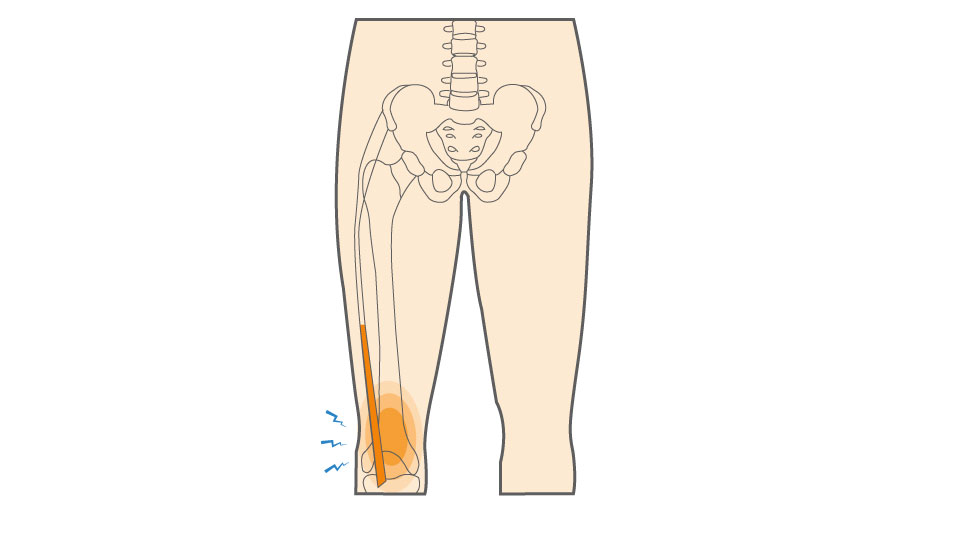Iliotibial band (IT) tendonitis, also called iliotibial band (IT) syndrome, is a condition characterized by inflammation that affects the iliotibial (IT) band of the upper leg. The IT band runs along the outer part of the thigh, from the hip to the knee. It consists of connective tissue called fascia, which connects the buttock and hip muscles to the top of the shin bone. In fact, the IT band is the largest fascia in the body and helps to stabilize the knee while running. IT band tendonitis is most common in runners. Because of its association with running, it is commonly known as runner’s knee, particularly when the primary symptom is lateral knee pain.
Iliotibial (IT) Band Tendonitis of the Knee Treatment
Iliotibial band (IT) tendonitis is a condition characterized by inflammation that affects the iliotibial (IT) band of the upper leg. The IT band runs along the outer part of the thigh, from the hip to the knee. IT band tendonitis is a non-traumatic injury that is brought on by overuse. It usually occurs in runners when the band is tight or has been overworked. This overuse injury is often referred to as IT band friction syndrome, especially when it results in lateral knee pain during repetitive movement.
Overview
Overview

What causes Iliotibial (IT) Band Tendonitis of the Knee?
IT band tendonitis is a non-traumatic injury that is brought on by overuse. It usually occurs in runners when the band is tight or has been overworked. Common causes of IT band tendonitis include:
- Overtraining
- Running only one course
- Wearing footwear that is worn out
- Improper foot mechanics
- Failing to stretch sufficiently
This overuse injury is common among athletes and recreational runners and can lead to conditions like IT band friction syndrome if not addressed early.
Iliotibial (IT) band tendonitis is common in these sports:
- Long-distance running or marathon running
- Soccer
- Tennis
Symptoms
You may have IT band tendonitis if you experience one or more of the following symptoms:
- Pain on the outside of the knee along the IT band
- Pain that increases when climbing or descending stairs
Such lateral knee pain is a hallmark sign of IT band friction syndrome and may also be described as a type of runner’s knee.
When to see a doctor
If you notice pain on the outside of the knee that does not resolve on its own, make an appointment with an orthopedic specialist, as this may indicate inflammation of the IT band. During your appointment, your doctor will check for tenderness by pressing on the outside of the knee. He/she will also assess the flexibility of the leg by having you perform various stretches, like the Ober’s test.
In order to make a diagnosis, your doctor may prescribe the following imaging tests to rule out other causes of knee pain:
- X-ray
- MRI
Non-operative treatment
IT band tendonitis is treated using conservative, non-operative methods. Treatment for IT band tendonitis may include:
- Rest
- Stretching (this is a key factor in IT band tendonitis treatment)
- Non-steroidal anti-inflammatory medication, like ibuprofen, to reduce inflammation
As improper foot and training mechanics may contribute to IT band tendonitis, your doctor may recommend the following treatments to reduce the risk of developing IT band tendonitis in the future:
- Correcting training errors
- Finding proper footwear to encourage proper foot mechanics
These strategies are crucial to managing runner’s knee and preventing a recurrence of this common overuse injury.
Try these exercises to help address your condition:
Below is a PDF of the Exercise Program
Surgical Treatment
IT band tendonitis does not require surgery and is almost always treated conservatively, using non-operative treatments.
Recovery
You can return to training when you have no pain and have regained flexibility in the leg. When you are recovering from IT band tendonitis, it is important that you return to running gradually. You will also need to make sure that you warm up carefully and stretch both before and after exercising. This will help prevent future cases of IT band friction syndrome and manage ongoing lateral knee pain effectively.
GET BACK TO WHAT YOU LOVE. FASTER
Sources
https://news.harvard.edu/gazette/story/2015/08/understanding-the-it-band/
https://www.webmd.com/pain-management/it-band-syndrome#1
https://www.emedicinehealth.com/iliotibial_band_syndrome/article_em.htm
https://www.runnersworld.com/it-band-syndrome
https://www.physio-pedia.com/Iliotibial_Band_Syndrome
https://www.medicinenet.com/iliotibial_band_syndrome/article.htm
Frequently Asked Questions
What are the most common symptoms of IT band tendonitis?
The most notable symptom is a sharp or burning pain on the outside of the knee, especially during or after repetitive activities like running, cycling, or climbing stairs. You might also feel tightness along the outer thigh or a snapping sensation as the IT band moves over the knee. Pain usually starts gradually and worsens with continued activity.
How long does recovery usually take once correctly diagnosed?
If treated promptly with rest, stretching, and proper footwear adjustments, recovery can take anywhere from 2 to 6 weeks. Severe or prolonged cases of runner’s knee may take longer.
How can I tell if I have IT band tendonitis or something else?
Lateral knee pain that worsens with repetitive motion or stair climbing is a hallmark of IT band friction syndrome, not typical of other knee injuries.
Is surgery ever needed if my diagnosis was delayed?
In nearly all cases of iliotibial (IT) band tendonitis of the knee, surgery is not necessary, even after delayed diagnosis. Most people respond well to conservative treatment once correctly diagnosed.

